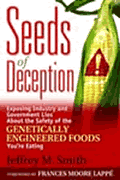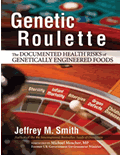Related
Articles:
Cal. County Bans Genetically Modefied Seeds (GMO's)
Hungarians
Protest Agains
GMO Grain
Other
Smith
Articles:
How to Avoid Genetically
Modefied Foods
AN
FDA-CREATED HEALTH CRISIS CIRCLES THE GLOBE
PART 2 of 2
By
Jeffrey Smith
October 21, 2007
NewsWithViews.com
Evaluations miss most health problems
Although the body of safety studies on GM foods is quite small, it has verified the concerns expressed by FDA scientists and others.
-
The gene inserted into plant DNA may produce a protein that is inherently unhealthy.
-
The inserted gene has been found to transfer into human gut bacteria and may even end up in human cellular DNA, where it might produce its protein over the long-term.
-
Toxic substances in GM animal feed might bioaccumulate into milk and meat products.
-
Farmer and medical reports link GM feed to thousands of sick, sterile, and dead animals.
But there is not a single government safety assessment program in the world that is competent to even identify most of these potential health problems, let alone protect its citizens from the effects.[21]
A review of approved GM crops in Canada by professor E. Ann Clark, for example, reveals that 70% (28 of 40) �of the currently available GM crops . . . have not been subjected to any actual lab or animal toxicity testing, either as refined oils for direct human consumption or indirectly as feedstuffs for livestock. The same finding pertains to all three GM tomato Decisions, the only GM flax, and to five GM corn crops.� In the remaining 30% (12) of the other crops tested, animals were not fed the whole GM feed. They were given just the isolated GM protein that the plant was engineered to produce. But even this protein was not extracted from the actual GM plant. Rather, it was manufactured in genetically engineered bacteria. This method of testing would never identify problems associated with collateral damage to GM plant DNA, unpredicted changes in the GM protein, transfer of genes to bacteria or human cells, excessive herbicide residues, or accumulation of toxins in the food chain, among others. Clark asks, �Where are the trials showing lack of harm to fed livestock, or that meat and milk from livestock fed on GM feedstuffs are safe?�[22]
Epidemiologist and GM safety expert Judy Carman shows that assessments by Food Safety Australia New Zealand (FSANZ) similarly overlook serious potential problems, including cancer, birth defects, or long-term effects of nutritional deficiencies.[23]
�A review of twelve reports covering twenty-eight GM crops - four soy, three corn, ten potatoes, eight canola, one sugar beet and two cotton - revealed no feeding trials on people. In addition, one of the GM corn varieties had gone untested on animals. Some seventeen foods involved testing with only a single oral gavage (a type of forced-feeding), with observation for seven to fourteen days, and only of the substance that had been genetically engineered to appear [the GM protein], not the whole food. Such testing assumes that the only new substance that will appear in the food is the one genetically engineered to appear, that the GM plant-produced substance will act in the same manner as the tested substance that was obtained from another source [GM bacteria], and that the substance will create disease within a few days. All are untested hypotheses and make a mockery of GM proponents� claims that the risk assessment of GM foods is based on sound science. Furthermore, where the whole food was given to animals to eat, sample sizes were often very low - for example, five to six cows per group for Roundup Ready soy - and they were fed for only four weeks.�[24]
Hidden information, lack of standards, and breaking laws
Companies claim that their submissions to government regulators are �confidential business information� so they are kept secret. Some industry studies that have been forced into the public domain through Freedom of Information requests or lawsuits have been appalling in design and execution. This is due in part to the lack of meaningful and consistent standards required for assessments. Gurian-Sherman says of the FDA�s voluntary consultation, �Some submissions are hundreds of pages long while others are only 10 or 20.�[25] A Friends of the Earth report on US regulation and corporate testing practices states, �Without standardization, companies can and do design test procedures to get the results they want.� [26]Regulators also reference international standards as it suits them. According to the Centre for Integrated Research in Biosafety, for example, FSANZ �relaxed adherence to international standards for safety testing when that better suited the Applicant�s submitted work, and imposed international standards whenever that was a lower standard than we recommended.�[27]
Regulators also break laws. The declaration of GRAS status by the FDA deviated from the Food and Cosmetic Act and years of legal precedent. In Europe, the law requires that when EFSA and member states have different opinions, they �are obliged to co-operate with a view to either resolving the divergence or preparing a joint document clarifying the contentious scientific issues and identifying the relevant uncertainties in the data.�[28] According to FOE, in the case of all GM crop reviews, none of these legal obligations were followed.[29]
Humans as guinea pigs
Since GM foods are not properly tested before they enter the market, consumers are the guinea pigs. But this doesn�t even qualify as an experiment. There are no controls and no monitoring. Without post-marketing surveillance, the chances of tracing health problems to GM food are low. The incidence of a disease would have to increase dramatically before it was noticed, meaning that millions may have to get sick before a change is investigated. Tracking the impact of GM foods is even more difficult in North America, where the foods are not labeled. Regulators at Health Canada announced in 2002 that they would monitor Canadians for health problems from eating GM foods. A spokesperson said, �I think it�s just prudent and what the public expects, that we will keep a careful eye on the health of Canadians.� But according to CBC TV news, Health Canada �abandoned that research less than a year later saying it was �too difficult to put an effective surveillance system in place.�� The news anchor added, �So at this point, there is little research into the health effects of genetically modified food. So will we ever know for sure if it�s safe?�[30]
Not with the biotech companies in charge. Consider the following statement in a report submitted to county officials in California by pro-GM members of a task force. �[It is] generally agreed that long-term monitoring of the human health risks of GM food through epidemiological studies is not necessary because there is no scientific evidence suggesting any long-term harm from these foods.�[31] Note the circular logic: Because no long-term epidemiological studies are in place, we have no evidence showing long-term harm. And since we don�t have any evidence of long-term harm, we don�t need studies to look for it.
What are these people thinking? Insight into the pro-GM mindset was provided by Dan Glickman, the US Secretary of Agriculture under President Clinton.
�What I saw generically on the pro-biotech side was the attitude that the technology was good, and that it was almost immoral to say that it wasn�t good, because it was going to solve the problems of the human race and feed the hungry and clothe the naked. . . . And there was a lot of money that had been invested in this, and if you�re against it, you�re Luddites, you�re stupid. That, frankly, was the side our government was on. Without thinking, we had basically taken this issue as a trade issue and they, whoever �they� were, wanted to keep our product out of their market. And they were foolish, or stupid, and didn�t have an effective regulatory system. There was rhetoric like that even here in this department. You felt like you were almost an alien, disloyal, by trying to present an open-minded view on some of the issues being raised. So I pretty much spouted the rhetoric that everybody else around here spouted; it was written into my speeches.�[32]
Fortunately, not everyone feels that questioning GM foods is disloyal. On the contrary, millions of people around the world are unwilling to participate in this uncontrolled experiment. They refuse to eat GM foods. Manufacturers in Europe and Japan have committed to avoid using GM ingredients. And the US natural foods industry, not waiting for the government to test or label GMOs, is now engaged in removing all remaining GM ingredients from their sector using a third party verification system. The Campaign for Healthier Eating in America will circulate non-GMO shopping guides in stores nationwide so that consumers have clear, healthy non-GMO choices. With no governmental regulation of biotech corporations, it is left to consumers to protect themselves.
To learn how to opt-out of the eating GMOs and to find non-GM alternative brands, click here.
New Book Genetic Roulette Documents Serious Health Dangers
The sourcebook for the Campaign is the newly released Genetic Roulette: The Documented Health Risks of Genetically Engineered Foods. With input from more than 30 scientists over two years, it presents 65 health risks of GM foods and why current safety assessments are not competent to protect us from most of them. The book documents lab animals with damage to virtually every system and organ studied; thousands of sick, sterile, or dead livestock; and people around the world who have traced toxic or allergic reactions to eating GM products, breathing GM pollen, or touching GM crops at harvest. It also exposes many incorrect assumptions that were used to support GM approvals. Organizations worldwide are presenting the book to policy makers as evidence that GM foods are unsafe and need to be removed immediately.
But we don�t need to wait for governments to step in. We can make healthier choices for ourselves, our families, and our schools now, and together we can inspire the tipping point for healthier, non-GM eating in America. We believe that this can be achieved within the next 24 months.
The GM crops sold in the US include soy (including soy lecithin used in chocolate and thousands of other products as an emulsifier), corn (including high fructose corn syrup), cottonseed and canola (both used in vegetable oil), Hawaiian papaya, and a small amount of zucchini and crook-neck squash. There is also alfalfa for cattle (the sale of which was halted by a federal judge on March 13, 2007), GM additives such as aspartame, and milk from cows treated with GM bovine growth hormone.
|
Subscribe to the NewsWithViews Daily News Alerts! |
There is not yet any GM popcorn, white corn or blue corn. And the industry is threatening to introduce GM sugar from sugar beets next year. To learn more, for online shopping guides and to find out how to get involved, click here.
The Institute for Responsible Technology�s plans to achieve the tipping point on GMOs through consumer education has inspired the Mercola.com Foundation to match donations and membership fees to the Institute at this time. Please help end the genetic engineering of our food supply by contributing to the implementation of this important project. Click here. For part one click below.
Click here for part-----> 1,
Footnotes:
1,
"Monsanto
Bribery Charges in Indonesia by DoJ and USSEC," Third World Network,
Malaysia, Jan 27, 2005,
2,
"Greenpeace
exposes Government-Monsanto nexus to cheat Indian farmers: calls on
GEAC to revoke BT cotton permission," Press release, March 3,
2005,
3,
Jeffrey M. Smith, Seeds
of Deception, (Iowa: Yes! Books, 2003), 224.
4,
See Federal Food, Drug and Cosmetic Act (FFDCA)
5,
Dan Quayle, "Speech in the Indian Treaty Room of the Old Executive
Office Building," May 26, 1992
6,
See Smith, Seeds of Deception; and for copies of FDA memos, see The
Alliance for Bio-Integrity,
7,
Steven M. Druker, "How
the US Food and Drug Administration approved genetically engineered
foods despite the deaths one had caused and the warnings of its
own scientists about their unique risks," Alliance for Bio-Integrity.
8,
Louis J. Pribyl, "Biotechnology
Draft Document, 2/27/92," March 6, 1992
9,
Linda Kahl, Memo to James Maryanski about Federal Register Document
"Statement of Policy: Foods
from Genetically Modified Plants," Alliance for Bio-Integrity(January
8, 1992)
10,
"Statement of Policy: Foods Derived from New Plant Varieties," Federal
Register 57, no. 104 (May 29, 1992): 22991.
11,
"Elements of Precaution: Recommendations for the Regulation of Food
Biotechnology in Canada; An Expert Panel Report on the Future of Food
Biotechnology prepared by The Royal Society of Canada at the request
of Health Canada Canadian Food Inspection Agency and Environment Canada"
The Royal Society of Canada, January 2001.
12,
Doug Gurian-Sherman, "Holes
in the Biotech Safety Net, FDA Policy Does Not Assure the Safety of
Genetically Engineered Foods," Center for Science in the Public
Interest,
13,
Bill Freese, "The StarLink Affair, Submission by Friends of the Earth
to the FIFRA Scientific Advisory Panel considering Assessment of Additional
Scientific Information Concerning StarLink Corn," July 17-19, 2001.
14,
FDA Letter,
Letter from Alan M. Rulis, Office of Premarket Approval, Center for
Food Safety and Applied Nutrition, FDA to Dr. Kent Croon, Regulatory
Affairs Manager, Monsanto Company, Sept 25, 1996. See Letter for BNF
No. 34
15,
See for example, "Good Enough To Eat?" New Scientist (February 9,
2002), 7
16,
"Health risks of genetically modified foods," editorial, Lancet, 29
May 1999
17,
"Elements of Precaution," The Royal Society
of Canada, January 2001.
18,
Friends of the Earth Europe, "Throwing Caution to the Wind: A review
of the European Food Safety Authority and its work on genetically
modified foods and crops," November 2004
19,
Friends of the Earth Europe and Greenpeace, "Hidden Uncertainties
What the European Commission doesn't want us to know about the risks
of GMOs," April 2006
20,
European Communities submission to World Trade Organization dispute
panel, 28 January 2005
21,
Jeffrey M. Smith, Genetic Roulette: The Documented Health Risks of
Genetically Engineered Foods, Yes! Books, Fairfield, IA USA 2007
22,
E. Ann Clark, "Food Safety of GM Crops in Canada: toxicity and allergenicity,"
GE Alert, 2000
23,
FLRAG of the PHAA of behalf of the PHAA, "Comments to ANZFA about
Applications A372, A375, A378 and A379."
24,
Judy Carman, "Is GM Food Safe to Eat?" in R. Hindmarsh, G. Lawrence,
eds., Recoding Nature Critical Perspectives on Genetic Engineering
(Sydney: UNSW Press, 2004): 82-93.
25,
Doug Gurian-Sherman,
"Holes
in the Biotech Safety Net, FDA Policy Does Not Assure the Safety of
Genetically Engineered Foods," Center for Science in the Public
Interest
26,
William Freese, "Genetically
Engineered Crop Health Impacts Evaluation: A Critique of U.S.
Regulation of Genetically Engineered Crops and Corporate Testing Practices,
with a Case Study of Bt Corn," Friends of the Earth U.S
27,
M. Cretenet, J. Goven, J. A. Heinemann,
B. Moore, and C. Rodriguez-Beltran, "Submission
on the DAR for Application A549 Food Derived from High-Lysine Corn
LY038: to permit the use in food of high-lysine corn, 2006
28,
EU Regulation 178/2002 (Article 30)
29,
Friends of the Earth Europe, "Throwing Caution to the Wind: A review
of the European Food Safety Authority and its work on genetically
modified foods and crops," November 2004
30,
"Genetically modified foods, who knows how safe they are?" CBC News
and Current Affairs, September 25, 2006
31,
Mike Zelina, et al., The Health Effects of Genetically Engineered
Crops on San Luis Obispo County," A Citizen Response to the SLO Health
Commission GMO Task Force Report, 2006
32,
Bill Lambrecht, Dinner at the New Gene
Caf�, St. Martin's Press, September 2001, pg 139
� 2007 Jeffrey M. Smith- All Rights Reserved
Sign Up For Free E-Mail Alerts
E-Mails are used strictly for NWVs alerts, not for sale
Jeffrey M. Smith is working with a team of international scientists to catalog all known health risks of GM foods. He is the author of Seeds of Deception, the world's bestselling book on GM food, and the producer of the video, Hidden Dangers in Kids' Meals.
Website: www.seedsofdeception.com
E:Mail: info@seedsofdeception.com
Genetically modified crops are the result of a technology developed in the 1970s that allow genes from one species to be forced into the DNA of unrelated species. The inserted genes produce proteins that confer traits in the new plant, such as herbicide tolerance or pesticide production.













